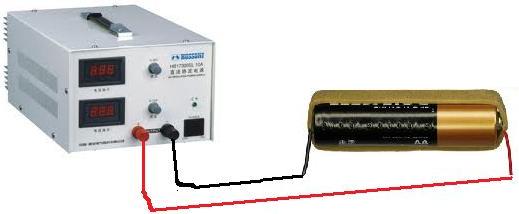How to Recharge Batteries with a DC Power Supply

You can easily recharge batteries if you have a DC power supply.
All that is needed to recharge battery cells is DC current. With DC current, electrons
will flow back into the battery, establishing the electric potential, or voltage, that a battery was meant
to have when it's fully charged.
Components Needed
- DC Power Supply
- Battery Holder (for battery that needs recharge)
- 2 Alligator Clips
- Battery to be Recharged
A DC Power Supply is needed that allows for adjustable voltage and current. Any such as that shown on the right will suffice to provide the voltage and current that we need in order to recharge a battery cell.
We use a battery holder for our battery because the battery holder gives us two leads (one
negative and one positive) so that we can connect it to the DC power supply via 2 alligator clips. Without
the battery holder and its leads, it would be very difficult to allow for connection with the battery cell.
So if we are charging a single 'AA' battery, we need a single 'AA' battery holder. If we are charging
2 'AA' batteries, we need a double 'AA' battery holder, and so on.
Power Requirements
Now how much voltage and current do we need to give from our DC power supply to recharge the batteries?
And the answer is, the battery you are recharging should come with a specification of the amount of current needed to recharge the battery. For example, a Duracell Rechargeable 'AA' Battery 2650mAh battery specifies the standard charge of 270mA for 16h. This means to recharge, you must supply it with 270mA. Follow the standard charge current of the battery to know the power requirements.
Again, batteries recharge on current. Voltage isn't as important. However, for safety, we will keep voltage low.
Setup
This is how the circuit will be set up:

The alligator clips were omitted in this depiction. However, they would connect from the battery holder test leads to the DC power supply output power terminals.
Using this setup, batteries can be charged and recharged. The important thing is to adjust the current to the right levels. In this case we are charging a 270mA 'AA' battery. Therefore, the current output must be 270mA. There are two ways to check if the correct current is being output. One is to change the DC Power Supply to the "Amp" Setting. It should display the amount of amperes being output. The next is to use a multimeter to read the amps output. Make sure that it's the current the battery was designed to be charged at. In this project, I kept the voltage at 3 volts and it dropped to about 1.8 volts when loaded with the battery.
If you want to charge multiple 'AA' batteries, the setup stays the same. This is because current remains the same in series. The only difference is it will take longer to charge, double the time, because it now has to charge 2. If you want to charge 4, it will take 4 times the time it would to charge one. However, current output remains the same.
To see our video on recharging batteries without a standard charger, with a DC power supply, see
How to Recharge Batteries Without a Charger (w/DC power supply).
Related Resources
How to Recharge Batteries with Solar Cells
Battery Specifications- Explained
